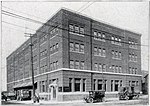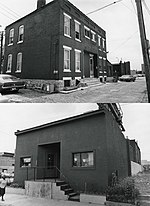Ford Motor Company - Columbus Assembly Plant

The Ford Motor Company - Columbus Assembly Plant is a historic building in Downtown Columbus, Ohio. The Ford plant was constructed in 1914, to designs by John Graham. The plant operated until 1939. In later years, it became the Kroger Co. Columbus Bakery, operating until 2019. The building was sold in 2020, and is planned to be redeveloped into a large residential complex, announced in 2021. The building was added to the National Register of Historic Places and Columbus Register of Historic Properties in 2021. The former Ford plant sits on a 9.5-acre (3.8 ha) site along with 457 Cleveland Avenue to its north, built in 1927 as a Kroger bakery. Together the buildings total 375,000 sq ft (34,800 m2).
Excerpt from the Wikipedia article Ford Motor Company - Columbus Assembly Plant (License: CC BY-SA 3.0, Authors, Images).Ford Motor Company - Columbus Assembly Plant
North Innerbelt, Columbus
Geographical coordinates (GPS) Address Nearby Places Show on map
Geographical coordinates (GPS)
| Latitude | Longitude |
|---|---|
| N 39.972726 ° | E -82.991061 ° |
Address
North Innerbelt
North Innerbelt
43215 Columbus
Ohio, United States
Open on Google Maps








